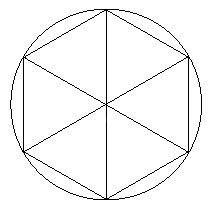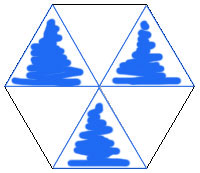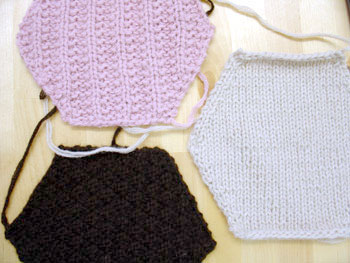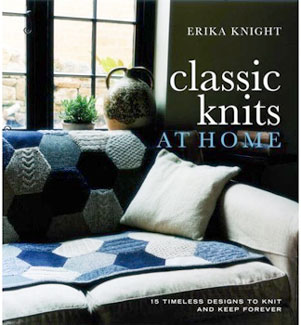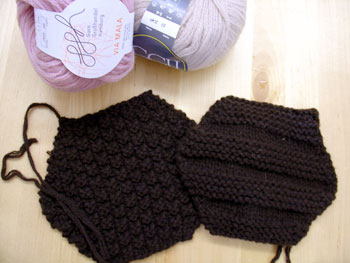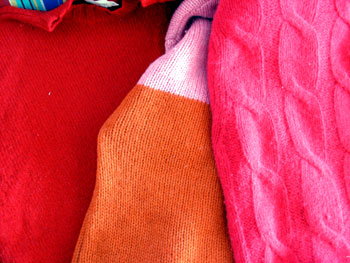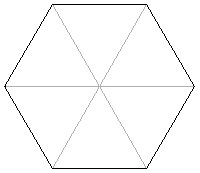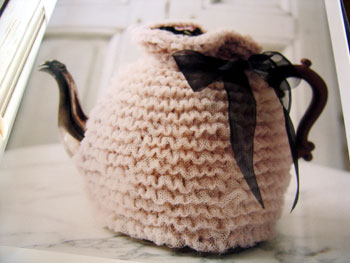![[return to the blue blog]](images/blueroom/blue_sheep_box.jpg)

patchwork hexagons
the knitsmithy the blue blog - archives works in progress finished projects free patterns contact: alison [at] knitsmiths [dot] us |
|
patchwork throw from Erika Knight's Classic Knits at Home using GGH Via Mala, other stash yarns and old sweaters
february 4, 2008
morning math When I drop my boys off at school, there's always the schedule for the day written on the board in their classroom. There's music and gym, word work, and sometimes morning math. Are you ready for a little hexagon math in the morning? I spent some more time over the weekend trying to calculate the proper size of the hexagons in Erika Knight's patchwork throw from her new book, Classic Knits at Home
We left off our mathematical musings by noting that a regular hexagon is made up of six equilateral triangles and fits perfectly inside a circle (and not inside a square). At knitsmiths over the weekend, knitbuddy Carol took a few minutes to tackle the hexagon puzzle with me and realized that the length of each side of the hexagon would have to be equal to half the length of hexagon at its widest point. She didn't use exactly these words, but here's the gist: the length of the hexagon at its widest point is actually the same measurement as the diameter of the circle that the hexagon would fit into. Half of that length is the radius of that circle and that's one side of each triangle in the hexagon. And since they're equilateral triangles, the side of the hexagon must equal the length of that radius. With me so far?
If I crudely color in a couple of the triangles you can see that the widest point of the hexagon is the same length as two triangles and one side of the hexagon is the same length as one triangle. Fun, huh?
If we then look at the diagram of the throw, we see that the width of the throw is equal to 4 hexagon diameters plus 3 hexagon sides. Since the hexagon diameter is equal to twice the side, the width of the throw is equal to 11 times the width of each hexagon side (8 + 3). Erika Knight gives the width of the throw at 45", so each hexagon side is (skip the calculator) a little more than 4". And the diameter of each hexagon is 8" (twice the length of the side). And it's height? Easy peasy. Divide one of the equilateral triangles into a right triangle and apply the pythagorean theorem. 4 (the hypotenuse) squared = 2 (the base of the right triangle) squared minus the height squared. Meaning, the height is (I got my calculator) a little more than 3 1/2". Soooo, the hexagon is twice that high, or about 7" high. Is that the 7" that Erika Knight first gave us??!!?!! Whew, how reassuring to actually find that number somewhere! Although I can only find one 7" measurement and still have no idea what 7" x 7" could mean. Still, can we verify that 7" height somehow just to be sure? Yes.
According to our diagram, the throw is six hexagons high and should measure 45". 6 hexagons at a wee bit more than 7" each is pretty darn close to 45". I'll take it! Okey dokey, I'll be making and blocking my hexagons to be 4" hexagons (that's 4" at each side) that measure 7" high and 8" wide. And I'll be cutting my fabric hexagons to those measurements plus a little seam allowance, of course. Don't we all feel better now?
posted by alison at 11:01 am
| comments (22)
january 31, 2008
hexagons, or the six-sided math problem I couldn't help myself.
After writing about the patchwork hexagon throw on the cover of Erika Knight's new book, Classic Knits at Home
Hexagon number one is in double moss stitch and number two is in a stockinette/garter stripe. Love that effect on the second one! What I really loved about this pattern is its mixture of knitting and fabric. I've already pulled out these old sweaters from the closet to use for at least some of the "fabric" hexagons.
I haven't decided if I want to felt them or not. I'm not even sure all of them will felt. And I'm not averse to steeking them. That way they'll have the same knitted look as the hexagons I'm knitting now. A throw that will use up stash yarns and old sweaters?! This... is... AWESOME! Except for the math. So here's the math problem: how do you measure a hexagon? Erika Knight, rather unhelpfully, gives the hexagons' proper measurement as 7" x 7". Um, that's not enough sides. It's not a square. It's not even an octagon that fits neatly into a square. It's a regular hexagon, with each side the same length, meaning that it is wider at its widest point than it is tall (uhhh, something about it being made from equilateral triangles and the hypotenuse being longer than the height of the two right triangles in each triangle, blah, blah, math, math...).
So what could the two equal measurements she gives refer to? A hexagon fits into a circle, soooo is the 7" the diagonal line between each of the points (or what would be the diameter of the circle that fits around the hexagon)? Then why give two measurements? In quilting, a hexagon's size is usually described by just one measurement: the length of each side. I'm confused. Look, all I need to know is what size should my hexagons be? I'll be using different yarns, so I need to have some idea of what size things should be. Her gauge info is, again rather disappointingly, no help since she only gives one gauge and that's in stockinette stitch, whereas all the hexagons are done in a variety of different stitch patterns from seed stitch to ribbing and even a cable! And I need to know what size should I cut my sweater hexagons. Don't get me wrong, I'm loving the hexagons, but oh, do I ever miss those mitred afghan squares! posted by alison at 10:27 am
| comments (17)
january 24, 2008
knit home Over my seven years of knitting, I've never really picked up the 'knitting for home' books. I've always wanted to make garments. Maybe a baby blanket, a stuffed animal or two, but things for the home? I don't have that sort of a home - you know, the kind with ruffly things and lacy things and clean things. My home is books, toys and functional ikea furniture. Every surface is covered with kids' stuff, craft stuff, and more kids stuff. No vases or pretty bowls or little art pieces. And no room for those lovely cushions and pretty pretty decorative items that one finds in the 'knitting for home' books. But then I started making blankets. It started with wee one's blankie, then new blankies for the boys, then the afghan for my in-laws, and now I'm quilting. Why am I so obsessed recently with blankets? Am I just cold? Blankets may possibly be the only home decor item that won't seem out of place in my home. Is there a natural progression from knitting for yourself to knitting for your home? After clothing yourself and your family in handknits is the next step to fill your home with them? Fact is, those knitting for home books look a lot more appealing to me these days. And one that's just caught my eye is Erika Knight's newest book, Classic Knits at Home: 15 Timeless Designs to Knit and Keep Forever
I love that throw on the cover! It's so cool. First of all, it's hexagons - I've already been dreaming about making a hexagon quilt. And second, it's a combination of knitted hexagons in different stitch patterns and fabric hexagons from different fabrics. I love the idea of combining fabric and knitting in a traditional pattern. That's what Erika Knight's done so well in this book. The patterns are classic and traditional, but they have something fresh and new about them too. Check out this awesome houndstooth pillow. Modern houndstooth - coool! Erika Knight's other new book, Glamour Knits at Home
Yeaaaaaahhhh, I'll probably be sticking to the hexagon throw. Maybe I could even felt down some old sweaters and cut hexagons from them as well. The pattern just has so many possibilities! Here I go, getting all excited about a blanket again.... posted by alison at 10:34 am
| comments (22)
|
